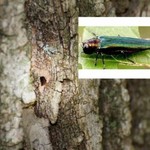
Dan Zarlenga - Aug 18, 2016 - mdc.mo.gov
ST. LOUIS, Mo. – That dreaded green beetle, the emerald ash borer (EAB), continues to spread its destructive influence.
The Missouri Department of Agriculture (MDA) confirmed earlier this month that EAB, an insect that kills ash trees, was found for the first time in Franklin County.
Missouri Department of Conservation (MDC) foresters say home and landowners in Franklin County need to make plans now to protect or replace their ash trees.
According to MDC Forest Entomologist Rob Lawrence, multiple adults were collected recently on an EAB trap set in Sullivan. The trap is one of more than 160 placed around the state by MDA. The annual survey is nearing completion, and traps are being collected and examined.
EAB have already been detected in bordering St. Charles County and in both St. Louis City and County. Franklin County is the 28th EAB-positive county in Missouri.
EABs are an Asian beetle that tunnel under the bark of ash trees, which disrupts the flow of water and nutrients and eventually kills the tree. The metallic, dark-green beetles are about one-inch long when fully developed. Larvae leave S-shaped tunnels under bark. Adults leave D-shaped exit holes in bark when they emerge. As their numbers grow, they cause more damage to a tree.
MDC foresters say homeowners will need to decide if they want to save a valued ash tree by beginning treatments next spring, or if they instead want to plant another tree species as an eventual replacement. In time, all untreated ash trees in an area harboring EAB can be expected to succumb to the insect.
Ash trees can be treated to protect them from the borers. Treatment costs vary by the size of tree and type of treatment used. Treatment costs can be as little as about $25 per tree for a do-it-yourself treatment on a small ash tree that must be repeated annually. But treatments can range up to a few hundred dollars for a large ash tree that is treated by a professional arborist on one- to three-year intervals, depending on type of treatment. Large ash trees cannot be effectively treated on a do-it-yourself basis.
It is too late this year to consider treatment because insecticides are most effective in spring and early summer when adults are active and larvae are beginning to develop, generally early May to June. But some treatments may need to be applied earlier in spring.
Most movement of EAB to new regions throughout the United States has been caused by people moving firewood. MDC foresters urge that firewood not be moved from one local area to another to help slow the spread of the pest. Those burning wood, including campers, are urged to buy locally harvested wood.
All Missouri counties are now under a federal and state quarantine preventing the movement of ash nursery stock, any parts of ash trees, and hardwood firewood out of the state of Missouri.
For more information about EAB, visit http://short.mdc.mo.gov/Z4C. The EAB section includes photos and videos of the insect and symptoms found on infected trees. There is also information that guides homeowners regarding treatment methods or how to get help from a certified arborist.



